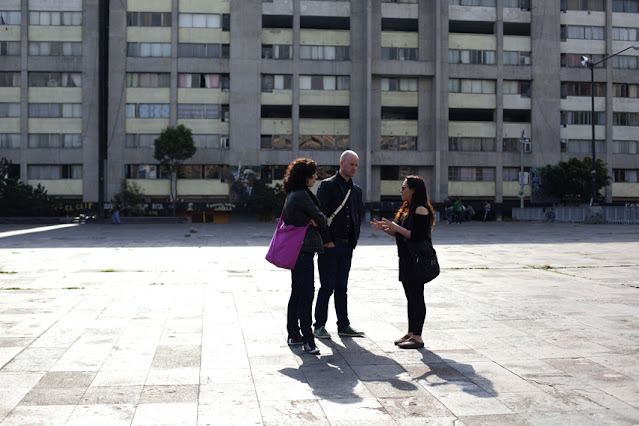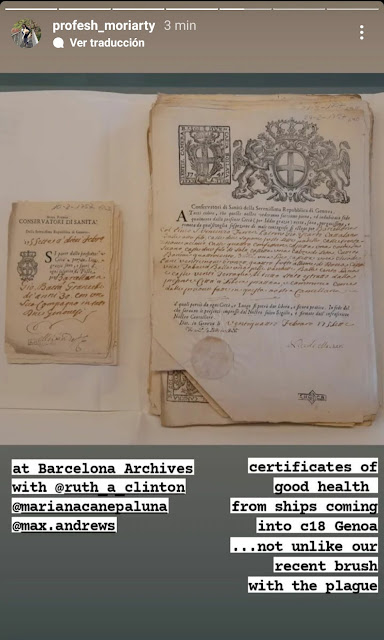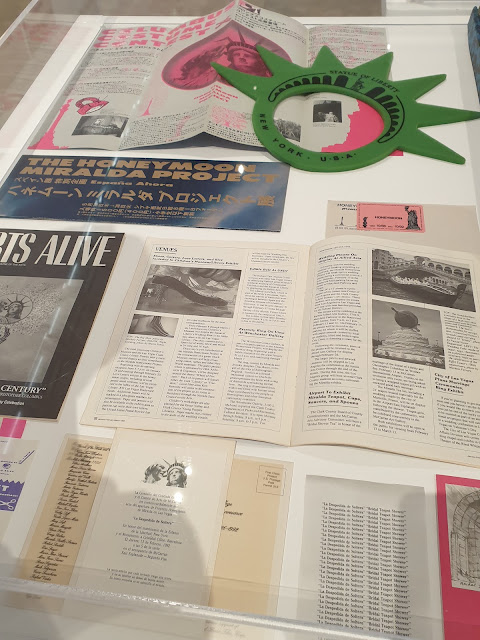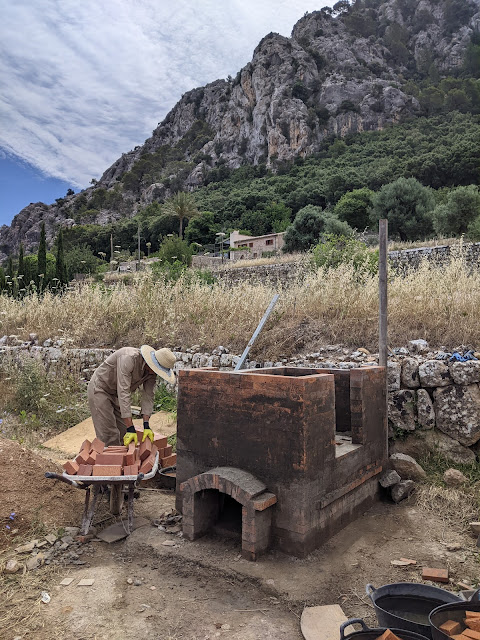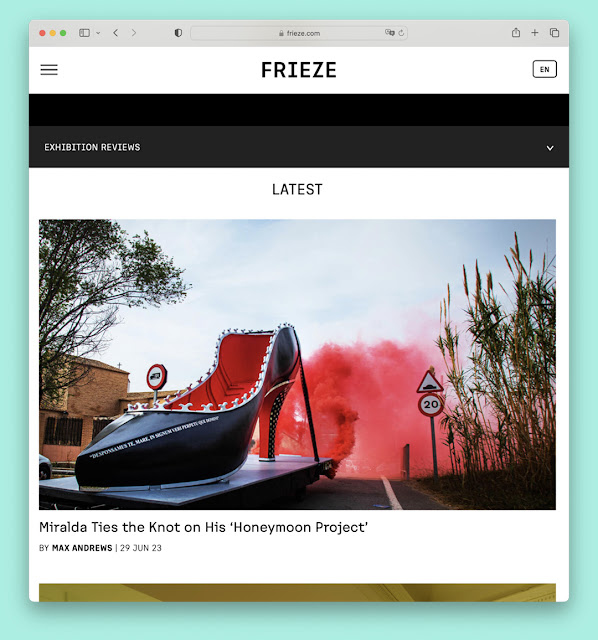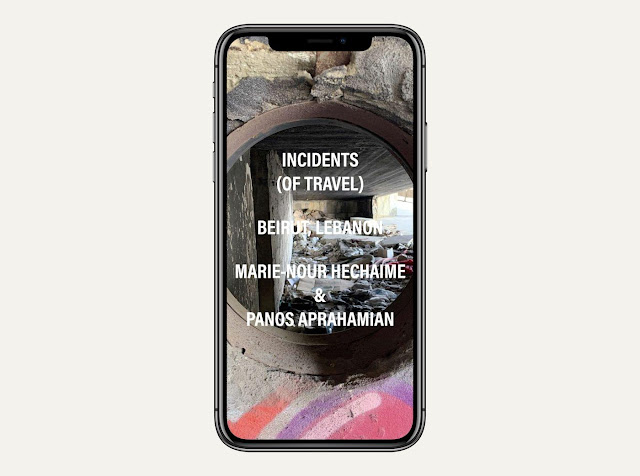Longitudes
Latitudes’ "out of office" 2022–23 season
Tue, Jul 25 2023Premio Laie DART 2022 de la Crítica (Laie DART 2022 Critics Award): “The Melt Goes On Forever: The Art and Times of David Hammons” (EEUU, 2021). Directed by cultural journalist Judd Tully and filmmaker Harold Crooks, the documentary focuses on the elusive figure of African-American artist David Hammons, whose artistic practice spans six decades and foregrounds social criticism in the United States.
16–18 May 2023: Work trip to València to visit Antoni Miralda’s exhibition “Miralda. Honeymoon: Unclassified” at Bombas Gens, curated by its artistic director Sandra Guimarães. The show centres on his “Honeymoon Project” (1986-1992), a series of intercontinental ceremonial actions around the romance and subsequent marriage between two historical monuments: that of Christopher Columbus, in the port of Barcelona, and the Statue of Liberty, in New York Bay. Max of Latitudes will review it for frieze’s October issue (online in June).
- Latitudes’ writing – exhibition reviews, artist profiles, interviews, catalogue essays, features, and opinions.
- Latitudes’ "out of office" 2021–22 season, 1 August 2022
- Latitudes’ "out of office" 2020–21 season, 2 August 2021
- Latitudes’ "out of office" 2019–20 season, 3 August 2020
- Latitudes’ "out of office" 2018–19 season, 1 August 2019
- Latitudes' "out of office" 2017–18 season, 2 August 2018
- Latitudes "out of office" 2016–17 season, 1 August 2017
- Latitudes' "out of office" 2015–16 season, 1 August 2016
- Latitudes' "out of office" 2014–15 season, 7 August 2015
- Latitudes' "out of office" 2013–14 season, 31 July 2014
- Latitudes' "out of office" 2012–13 season, 31 July 2013
- Latitudes' "out of office" 2011–12 season, 31 July 2012
- Latitudes' "out of office" 2010–11 season, 1 August 2011
- Latitudes' "out of office" 2009–10 season, 30 July 2010
- Latitudes' "out of office" 2008–9 season, 30 July 2009
2022 in 11 monthly Cover Stories
Tue, Dec 27 2022→ RELATED CONTENT:
- 2019 in 10 monthly Cover Stories, 23 Dec 2019
- 2020 in 11 monthly Cover Stories, 28 Dec 2020
- 2021 in 11 monthly Cover Stories, 31 Dec 2021
Cover Story, November 2022: Jorge Satorre’s Barcelona
Tue, Nov 1 2022The November 2022 monthly Cover Story “Jorge Satorre’s Barcelona” is now up on our homepage: www.lttds.org
“Below the Tibidabo Amusement Park, just where the BV-1418 and BP-1417 roads meet, there are some stairs that go up into the forest. Climbing them, a few meters up on the right, we will find a large stone hidden among the trees.” Continue reading
After November 2022 this story will be archived here.
Cover Stories are published on a monthly basis on Latitudes’ homepage featuring past, present or forthcoming projects, research, texts, artworks, exhibitions, films, objects or field trips related to our curatorial projects and activities.
- Archive of Monthly Cover Stories
- Cover Story, September 2021: Erratic behaviour—Latitudes in conversation with Jorge Satorre, 31 August 2021
- Web of the artist about “The Erratic. Measuring Compensation”
- Publication "Robert Smithson: Art in Continual Movement” (Alauda Publications, 2012) includes an essay by Max Andrews, 28 Mar 2012
- Lecture by Max Andrews “From Spiral to Spime: Robert Smithson, the ecological and the curatorial”, 13 March, 2pm, Lecture Theatre 1, Royal College of Art, London, 12 March 2012
- Interview with Erick Beltrán & Jorge Satorre published in “Atlántica” magazine #52, 13 Feb 2012
- Proyecto producido por Jorge Satorre para “Portscapes” (2009) expuesto en la exposición colectiva “Fat Chance to Dream”, Maisterravalbuena, Madrid, 29 Mar 2011
- 2009 Video of the making of Jorge Satorre's project
- Portscapes news: Jorge Satorre's billboard on the A15 and Paulien Oltheten's small exhibition at the visitor centre Futureland and surroundings, 2 October 2009
20th and concluding dispatch of “Incidents (of Travel)” from Barcelona, Spain
Wed, Oct 26 2022The second dispatch came from Jinja in Uganda, where curator Moses Serubiri invited photographer Mohsen Taha to explore Jinja's Indian architectural legacy and Idi Amin's notorious expulsion of Uganda's Asian minority in 1972.
The third episode took place while curator Yu Ji and poet Xiao Kaiyu hiked on Dong Shan (East Mountain), 130 km west of Shanghai, on a peninsula stretching into Tai Hu lake near the city of Suzhou, China.
The fourth dispatch came from Lisbon, where Galician curator Pedro de Llano visited key locations that marked the life and work of Luisa Cunha.
The fifth episode took place in April 2016, when curator Simon Soon and artist chi too visited the Malaysian North Eastern state of Terengganu, where chi spent some time in 2013, surrounded by “men and women who work(ed) multiple jobs as fishermen, housebuilders, boat builders, farmers, coconut pickers, food producers, and everything else that matters.”
The sixth episode narrates a walking itinerary conducted by curator Marianna Hovhannisyan with Vardan Kilichyan, Gohar Hosyan, and Anaida Verdyan in Yerevan, the capital of Armenia, documenting the transformed, disappeared, or permanently-closed art institutions in the city centre.
The seventh episode comes from Hobart, the capital of Tasmania. It is narrated by curator Camila Marambio, following an itinerary devised by artist Lucy Bleach. They spent the day "encircling the outer limits of human understanding by visiting the histories, both past, and present, of attempts to reach beyond our sensory capacities through governance, technology, and reverie", and ended the day cooking at Lucy's home-sharing their mutual love for quinces.
In the eighth 'Incidents (of Travel)' dispatch Móvil co-founder and curator Alejandra Aguado followed the itinerary devised by the artist Diego Bianchi around Buenos Aires, Argentina.
In the ninth dispatch, Canadian curator Becky Forsythe and Icelandic artist Þorgerður Ólafsdóttir navigate Reykjavík's surroundings considering Þorgerður's “current interest in Icelandic Spar (a form of transparent calcite), its double refraction and light-polarizing properties. In a race with daylight, they travel between sites collecting moments and considering the ways in which geologic time surfaces in the context of human time.”
The tenth dispatch begins with an itinerary proposed by Barcelona-born, Rio de Janeiro-based artist Daniel Steegmann Mangrané and is followed by images and videos recording a day roaming Rio's natural and artistic landscapes with Bogotá-born, Mexico City-based curator Catalina Lozano, who narrates their day spent together.
In the 11th episode, Swiss curator Sandino Scheidegger (Random Institute) visits Panama City in preparation for a solo exhibition by Donna Conlon and Jonathan Harker at Casa Santa Ana in 2021.
The 12th episode from Tbilisi, Georgia, set a different tone in the online series as it was programmed to take place in late May 2020, during the Covid-19 pandemic.
https://www.lttds.org/longitudes/index.php?id=7159211982397983135/episode-12-of-incidents-of-travel
Episode #11 of ‘Incidents (of Travel)’ – Dispatch by Sandino Scheidegger and Donna Conlon & Jonathan Harker from Panama City, 9 April 2020
https://www.lttds.org/longitudes/index.php?id=4425215029591365006/11-episode-of-incidents-of-travel
Tenth episode of ‘Incidents (of Travel)’ – Dispatch by Catalina Lozano and Daniel Steegmann Mangrané from Rio de Janeiro,
29 January 2020
https://www.lttds.org/longitudes/index.php?id=144735152408473327/tenth-episode-of-incidents-of-travel
The ninth episode of ‘Incidents (of Travel)’ – Dispatch by Becky Forsythe and Þorgerður Ólafsdóttir, 8 February 2019
https://www.lttds.org/longitudes/index.php?id=6371927610418460689
The eighth episode of ‘Incidents (of Travel)’ – Dispatch by Alejandra Aguado and Diego Bianchi, 6 September 2019
https://www.lttds.org/longitudes/index.php?id=8721104601538735691
The seventh episode of ‘Incidents (of Travel)’ – Dispatch by Camila Marambio and Lucy Bleach from Hobart, Tasmania, 28 June 2018
https://www.lttds.org/longitudes/index.php?id=1055853895543348027
The sixth episode of ‘Incidents (of Travel)’ – Dispatch by Marianna Hovhannisyan and students from the National Center of Aesthetics from Yerevan, Armenia, 1 March 2018
http://www.lttds.org/blog/blog.php?id=5887133486742947361
The fifth episode of 'Incidents (of Travel)' – Dispatch by Simon Soon and chi too from Terengganu, Malaysia, 26 April 2017
http://www.lttds.org/blog/blog.php?id=4083951540089486920
The fourth episode of 'Incidents (of Travel)' – Dispatch by Pedro de Llano and Luisa Cunha from Lisbon, Portugal, 2 March 2017
http://www.lttds.org/blog/blog.php?id=4185860148466062617
The third episode of 'Incidents (of Travel)' – Dispatch by Yu JI and Xiao Kaiyu reporting from Suzhou, China, 6 September 2016
http://www.lttds.org/blog/blog.php?id=1437935620149738144
Second 'Incidents (of Travel)' dispatch by Moses Serubiri and Mohsen Taha reporting from Jinja, Uganda, 30 June 2016
https://www.lttds.org/longitudes/index.php?id=2504250800654900933
Kadist and Latitudes present 'Incidents (Of Travel)' online, 31 May 2016
http://www.lttds.org/blog/blog.php?id=1076947282278624159
2021 in eleven monthly cover stories
Fri, Dec 31 2021Since Spring 2015, Latitudes has published a monthly cover story on its homepage www.lttds.org featuring past, present or forthcoming projects, as well as ongoing research, texts, artworks, exhibitions, films, objects, or travel related to our curatorial practice. Here's how 2021 looked like on our homepage.
- 2019 in 10 monthly Cover Stories, 23 Dec 2019
- 2020 in 11 monthly Cover Stories, 28 Dec 2020
Conversación en línea con Jorge Satorre, 22 de septiembre a las 19h UTC
Tue, Sep 14 2021- Cover Story, September 2021: Erratic behaviour—Latitudes in conversation with Jorge Satorre, 31 August 2021
- Portscapes project page
- Portscapes photo documentation
- Web of the artist about ‘The Erratic. Measuring Compensation’
- Review of the exhibition "What cannot be used is forgotten" in the May issue of frieze 29 April 2015
- Publication "Robert Smithson: Art in Continual Movement" (Alauda Publications, 2012) includes essay by Max Andrews, 28 Mar 2012
- Lecture by Max Andrews "From Spiral to Spime: Robert Smithson, the ecological and the curatorial", 13 March, 2pm, Lecture Theatre 1, Royal College of Art, London, 12 March 2012
- Interview with Erick Beltrán & Jorge Satorre published in 'Atlántica' magazine #52, 13 Feb 2012
- Proyecto producido por Jorge Satorre para 'Portscapes' (2009) expuesto en la exposición colectiva 'Fat Chance to Dream', Maisterravalbuena, Madrid, 29 Mar 2011
- 2009 Video of the making of Jorge Satorre's project
- Portscapes news: Jorge Satorre's billboard on the A15 and Paulien Oltheten small exhibition at the visitor centre Futureland and surroundings, 2 October 2009
Cover Story, September 2021: Erratic behaviour—Latitudes in conversation with Jorge Satorre
Tue, Aug 31 2021The September 2021 monthly Cover Story “Erratic behaviour—Latitudes in conversation with Jorge Satorre” is now up on our homepage: www.lttds.org
“In 2008 the Port of Rotterdam in the Netherlands, the largest in Europe, began a dramatic project to extending its land by 20% into the sea. Known as Maasvlakte 2, the construction involved bringing more than 5 million tons of rock from Scandinavia for the construction of dikes and dams, alongside a programme of ecological offsetting. ”
→ After September 2021 this story will be archived here.
Cover Stories' are published on a monthly basis on Latitudes' homepage featuring past, present or forthcoming projects, research, texts, artworks, exhibitions, films, objects or field trips related to our curatorial projects and activities.
- Archive of Monthly Cover Stories
- Cover Story–July-August 2021: Panorama: a wide view from a fixed point, 2 July 2021
- Cover Story–June 2021: ‘Fitness food: Salim Bayri’s Amsterdam’, 1 June 2021
- Cover Story–May 2021: RAF goes viral, 2 May 2021
- Cover Story—April 2021: Cover Story – April 2021: Lara Almarcegui at La Panera, 2 Apr 2021
- Cover Story—March 2021: Eulàlia Rovira's ‘A Knot Which is Not’ (2020–21), 1 mar 2021
- Cover Story—February 2021: ‘Straits Time: narrative smuggling in Singapore’, 1 Feb 2021
- Cover Story–January 2021: ‘Things Things Say’: VIP's Union’, 1 Jan 2021
Review of the exhibition "What cannot be used is forgotten" in the May issue of frieze
Wed, Apr 29 2015As reported earlier in this channel, at the end of last January we visited the exhibition 'Ce qui ne sert pas s’oublie' (What Cannot be Used is Forgotten)' (on view until 3 May 2015) at CAPC musée d'art coontemporain in Bordeaux.
Curated by Mexico-based Colombian-born curator Catalina Lozano, the exhibition presents the work of Mathieu K. Abonnenc, Sven Augustijnen, Mariana Castillo Deball, Sean Lynch, Pauline M’Barek, Museo Comunitario del Valle de Xico, Wendelien van Oldenborgh, Uriel Orlow, Beatriz Santiago Muñoz and Jorge Satorre.
Below is a fragment of Max Andrews' frieze review, published in the May 2015 issue of frieze magazine (#171):
‘What cannot be used is forgotten’ proposed a biographical approach to objects and the histories and allegiances they can constitute. With an emphasis on eroding the legacy of colonial-era ethnography and archaeology, the exhibition comprised the contributions of ten artists who emphasized the accrual and dispersal of objects' meaning over time. Objects were broken apart, animated, revered, rumoured, memorized, melted; or – as in Pauline M’Barek’s sculptures mimicking display stands for imagined wooden masks – missing altogether. Sometimes, objects were not comfortably objects at all, but textiles or techniques. Occasionally they were alibis employed to provoke historical revision and necessitate textual commentary. In Uriel Orlow’s A Very Fine Cast (110 years) (2007), works ingested past traces of such commentary (captions taken from European museums’ descriptions of the Benin Bronzes robbed by the British punitive Benin Expedition of 1897).
– Max Andrews
Report from Bordeaux: Visit to CAPC/Musée d'Art Contemporain's shows of Franz Ehrard Walther and the group show "Ce qui ne sert pas s'oublie" (27 January 2015)
Review of Maria Thereza Alves' exhibition at CAAC Sevilla published in frieze magazine (9 March 2015)
art-agenda review on Andrea Büttner show "Tische", at NoguerasBlanchard, Barcelona (21 July 2014)
–
This is the blog of the independent curatorial office Latitudes. Follow us on Facebook and Twitter.
All photos: Latitudes | www.lttds.org (except when noted otherwise in the photo caption).
Work is licensed under a Creative Commons Attribution-NonCommercial-NoDerivs 3.0 Unported License.
Report from Bordeaux: Visit to CAPC/Musée d'Art Contemporain's shows of Franz Ehrard Walther and the group show "Ce qui ne sert pas s'oublie"
Tue, Jan 27 2015The exhibition 'Franz Erhard Walther: Le Corps décide' was initiated by WIELS Centre d’Art Contemporain, in Brussels – see a video of its iteration here – and has been co-produced together with CAPC musée d'art contemporain in Bordeaux, alongside The Franz Erhard Walther Foundation. The exhibition is accompanied by a beautiful publication that includes brightly colored pop up shapes that spread throughout the book.
From Wiels' website... "Franz Erhard Walther’s exhibition offers an in-depth look at an influential German artist whose pioneering work straddles minimalist sculpture, conceptual art, abstract painting, and performance all while positing fundamental questions about the conventional idea of the artwork as an immutable, obdurate pedestal or wall-bound thing. Bringing together pivotal works made between the 1950s and the present, this exhibition focuses on Walther’s ability to transform notions of object-hood and perception through drawings, paintings, fabric sculptures, participatory forms, language-based works, photographic documentation and archival material."
The exhibition "deals with the mutating statuses of objects in relation to the possible historical narratives, especially those related to colonial past an present and the layers of cultural, spiritual and identity production that stem from them. Objects carry a wealth of immaterial aspects in and around their materiality, constituted by means of the relations they form with others, both human and non-human... This exhibition seeks to understand how our relation to the material world entails endless processes of assimilation, acculturation, re-appropriation, ritualisation which in their complexity whiteness and embody the historical binds in which they are caught." [this and following quotations describing each work are taken from the exhibition leaflet].
The exhibition is accompanied by a French/Spanish publication (Les Presses du Réel, 2015) with contributions by Mathieu K. Abonnenc, Mariana Castillo Deball, Catalina Lozano, Beatriz Santiago Muñoz and Jorge Satorre.
The first room of the exhibition featured 'Killing Pots' (2013–14), a series of sculptural works by Jorge Satorre (1979, Mexico). Information about these pieces can be found in this extensive text by curator Caterina Riva.

 (Left) 'Nocturne' (2015) a video by Beatriz Santiago Muñoz (1972, Puerto Rico); (right) Mathieu K. Abonnenc (1977, French Guyana) 'Sas titre (des corps entassés'), (2012) and 'Names and surnames' (2012-13).
(Left) 'Nocturne' (2015) a video by Beatriz Santiago Muñoz (1972, Puerto Rico); (right) Mathieu K. Abonnenc (1977, French Guyana) 'Sas titre (des corps entassés'), (2012) and 'Names and surnames' (2012-13).The show closes with two works produced in 2007 by Uriel Orlow (1973, Switzerland): "Lost Wax" and "A Very Fine Cast (110 Years)". The first deals with the production of brass-casting artefacts in Benin City, Nigeria, produced via this already out of use technique. The latter (below) is a series of 28 engravings displaying descriptions of artefacts from museum cataloguing systems, revealing the racist and colonial narratives that lie within the looted objects that are now part of European museum collections.
- Report from the Amsterdam Art Weekend, 27–30 November 2014 (2 December 2014)
- Report from London's Frieze week 2014 (27 October 2014)
- Report from Madrid: Exhibitions during Apertura 2014 Gallery Weekend (15 September 2014)
- Report from Glasgow: Lecture at The Common Guild and studio and gallery visits (4 December 2013)
- Report from Paris: FIAC week, 21–28 October 2013 (5 November 2013)
- Report from Athens: "AGORA", 4th Athens Biennale 2013 (4 November 2013)
- Report from New York: Gramsci Monument, visiting critics at ISCP, Carol Bove at The High Line and galleries route (23 September 2013)
This is the blog of the independent curatorial office Latitudes. Follow us on Facebook and Twitter.
All photos: Latitudes | www.lttds.org (except when noted otherwise in the photo caption)
Work is licensed under a Creative Commons Attribution-NonCommercial-NoDerivs 3.0 Unported License.
Publication "Robert Smithson: Art in Continual Movement" (Alauda Publications, 2012) includes essay by Max Andrews
Wed, Mar 28 2012 |
| Cover of the publication. All photos: Latitudes | www.lttds.org |
Edited by: Ingrid Commandeur and Trudy van Riemsdijk-Zandee
Authors: Max Andrews, Eric C.H. de Bruyn, Stefan Heidenreich, Sven Lütticken, Anja Novak, Vivian van Saaze
Design: Esther Krop
ISBN: 9789081531481
Available in bookshops or order online: alaudapublications.nl
- September 2011 blog post on The Land Art Contemporary programme in Denthe, The Netherlands.



